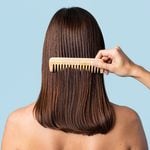Female Hair Loss: Should You Be Worried?
What every woman needs to know about female hair loss

Female Hair Loss at a Glance
Chrome Drone. The Horseshoe. While male-pattern baldness receives no shortage of awareness- even if it is through unfortunate monikers like these – it’s a health topic that receives little to no public acknowledgement for women.
Most of us are used to a bit of shedding in the shower or on our brushes. The Ottawa-based Canadian Dermatology Association (CDA) estimates that we lose about 100 of our 100,000 hairs each day but adds that this is completely normal and most of it will grow back.
When to start worrying
What’s more worrisome are bald patches or a widening of your part. “An estimated 30 percent of women over the age of 40 and 45 percent of post-menopausal women suffer from hair loss,” says Dr. Vincent Durosier, medical affairs manager for Ducray Dermatological Laboratories in Toulouse, France. Here’s what’s going down on top of our heads.
When it comes to growing our locks, on average, we grow about half an inch of hair each month, but Dr. Durosier says it grows in a discontinuous fashion. That means that not all the aforementioned 100,000 hair follicles sprout hair at the same time – in fact, each hair grows on our head and stays there for about three to six years before falling out.
Treatment Options For Women Experiencing Hair Loss
If you’re noticing hair loss, your first stop should be your family physician. According to Dr. Jeff Donovan, a dermatologist with offices in Toronto and Vancouver, there are a number of common culprits, including weight changes, stress and iron, thyroid or nutritional deficiencies.
There are many options to help grow your hair back.
Topical Treatments
Minoxidil, also known as Rogaine, is a topical liquid treatment applied directly to your scalp and is likely the first line of defence for those diagnosed with chronic hair thinning. However, it’s not a guaranteed fix, says Dr. Donovan. “If someone comes to see me with genetic hair loss, I may recommend minoxidil, but I know that only about 35 percent of women who are advised to take it will see any improvement,” he says. Notably, it also takes six to seven months before any hair growth will be noticeable.
Topical steroids like clobetasol, fluocinonide and hydrocortisone may be suggested for other hair loss conditions, such as alopecia areata and other autoimmune hair loss problems, but these aren’t treatments for genetic hair loss. For chronic telogen effluvium, hair loss tends to be short term, with occasional exacerbations, says Dr. Durosier. “And temporary benefits may sometimes be achieved with a short course of topical steroids,” he adds.
Non-Surgical Treatments
Platelet-rich plasma (PRP) therapy is another option to protect your tresses because it’s designed to stimulate growth rather than stop hair loss. “This is a treatment where we use the patient’s own blood and the growth factors in their blood to stimulate hair growth,” says Dr. Donovan. Blood is drawn and spun out so that the plasma is separated and then reinjected into the scalp to encourage hair regrowth.
Additional non-surgical options include low-level laser treatments, where lasers are used to trigger hair growth by stimulating blood flow to the scalp and pushing the hair follicles into growing again. Anti-androgens, or hormone-blocking pills, such as spironolactone or finasteride (Propecia), and even oral contraceptives can help slow – and possibly stop – hair loss. All of these block the hormone testosterone, which can cause hair loss in some women because their hair is sensitive to the androgens.
“Nutritional supplements are effective for some conditions,” says Dr. Durosier. “First, one must ensure that the hair loss isn’t due to an iron deficiency or a hormonal imbalance.” If an iron deficiency is the issue, then supplements would be recommended. A vitamin D supplement can also help.
Proper nutrition is important. “Individuals with low iron and zinc can develop excessive hair shedding,” he says. “While people typically lose 50 to 100 hairs each day, individuals with low iron or zinc can experience much greater levels of hair loss.” Along with zinc, the mineral silica is also critical. “Great food sources of silica include cucumber, mango, leafy greens, beans, celery, strawberries and asparagus,” says Jenn Pike, a holistic nutritionist in Keswick, ON.
She points to a double-blind, placebo-controlled study conducted in 2007 by the University of Cincinnati in which 48 women were given 10 milligrams of bioavailable silica each day or a placebo for nine months. Although the study was small, the researchers concluded that the women taking silica had thicker hair and improved growth due to increased elasticity and tensile strength.
And don’t forget about zinc-rich foods. “For those, there are pumpkin seeds, fresh oysters, brazil nuts, organic eggs and pecans,” she adds.
Related:




